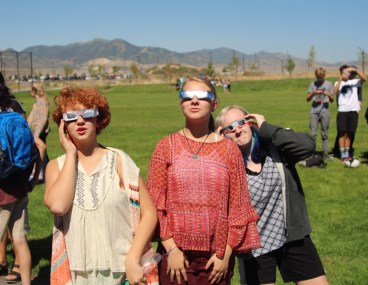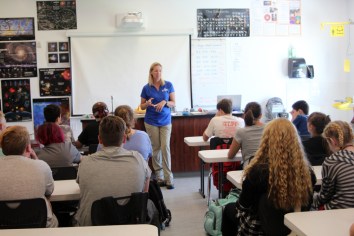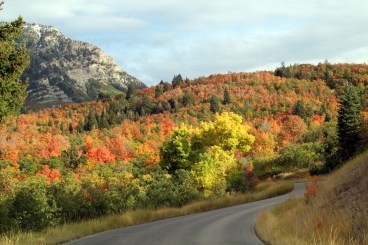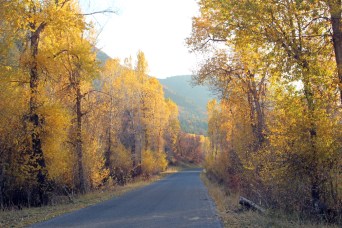
I attended the Research Teacher Data Conference at the Grand Hyatt Hotel in Washington, D.C. on Oct. 13-15, 2017.
Oct. 13-15, 2017
Grand Hyatt Hotel, Washington, D.C.
One of the many ironies of being laid off at American Academy of Innovation is that I still had unfinished business as a teacher to attend to even if I wasn’t teaching any longer. The week before I left, I submitted a STEM Classroom Grant application to the Utah STEM Action Center asking for $1500 to pay for materials for our UAV workshop at the digital citizenship conference. I found out a few weeks later that the grant had been approved, but I have no idea if the money was ever received or used for its intended purposes.
Another holdover was my scheduled attendance at a Research Data Teacher Conference in Washington, D.C. on October 13-15, 2017 sponsored by the Society for Science and the Public, the people who administer the International Science and Engineering Fairs and the Regeneron Science Talent Search. I had heard about the conference and applied for the opportunity while I was still in Bali, Indonesia, then heard a few weeks into the school year that I had been accepted. The trip was all-expenses-paid and there were no out of pocket costs to deplete my non-existent income, so I decided to go ahead and take the trip as planned. They would even provide a $100 credit card to cover meal expenses while traveling. I had never been to D.C. in the fall, and this would get my mind off of my unemployment troubles and perhaps provide some good contacts and networking.
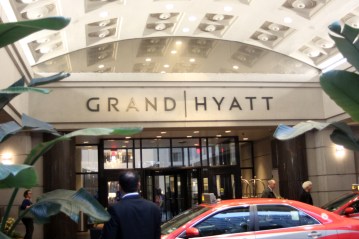
The Grand Hyatt Hotel in Washington, D.C., site of our Research Teacher Data Conference.
I was scheduled to present with Cindy Rogers, a teacher from Texas I had never met, on the engineering design process. We e-mailed back and forth and put together a good presentation. I did the initial Powerpoint, with additions from Cindy. We would have the participants do the bridge building exercise I’ve done in my Innovation Design classes.
I took my normal flight, Delta 832, across the country and watched part of the movie Inferno with Tom Hanks based on the latest Dan Brown code-breaking thriller. We landed at Washington Reagan, coming in over the Potamac as usual for a steep and fast landing. I got my luggage at the baggage claim downstairs and met up with other arriving teachers at Baggage Claim 12. They had a shuttle bus all ready for us, and we stowed our bags underneath and climbed aboard. The best part of these programs is meeting teachers from around the country, and a lively discussion started as we drove across the Potamac to the Grand Hyatt hotel.

Grand Hyatt Hotel interior courtyard
This was my fourth trip to D.C. in as many years, and I had lived and worked and visited here ever since I was in college, so I’ve gotten to know the city well. I was here just eight months ago for the Teachers for Global Classrooms symposium. This was my first time at the Grand Hyatt, however, and it is quite a hotel with a large inside atrium. I checked in at the main desk and took my bags to my room, which was around on the opposite side of the hotel from the bank of elevators.
We held an opening banquet downstairs from the main lobby and sat by geographical regions. There were two other teachers at my table from Utah, one named Enrique from West High School in Salt Lake City, the other was Charmaine from a charter school in St. George. There were about 200 teachers altogether, all paid for by donations from sponsors to the Society for Science and the Public. The main sponsor is now Regeneron. It used to be Intel, and long ago in my high school days it was sponsored by Westinghouse and was called the Westinghouse Science Talent Search, which I entered as a senior in high school with my project to make a system of methanol-air fuel cells. I did not make it in, but I did make it into the Utah Science Talent Search and won fourth place behind my friends Nicole Van der Heyden and Sven Berg. So this whole meeting felt to me as if I were coming full circle at last. My efforts as a high school science nerd were finally paying off.
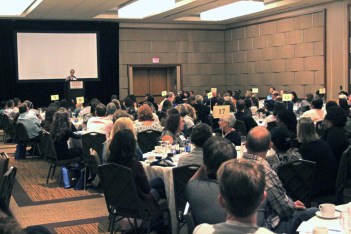
Opening Banquet for the Research Teacher Data Conference. Over 200 teachers were selected and provided an all expenses paid trip to the conference, including three of us from Utah.
Caitlin Sullivan welcomed us to the conference. The purpose of this meeting was to train and encourage like-minded middle and high school science teachers to promote and support students in their efforts to collect data and create science fair projects. We were to attend a series of workshop sessions over two days led by pairs of teachers, including the one led by Cindy and I. During and after the meal, I got to know the other teachers at the table. They were an interesting lot and people I wished I could work with at some future time. Not actually being a teacher at the moment was quite a hindrance for setting up collaborations, since I don’t have any students that their classes can team up with.
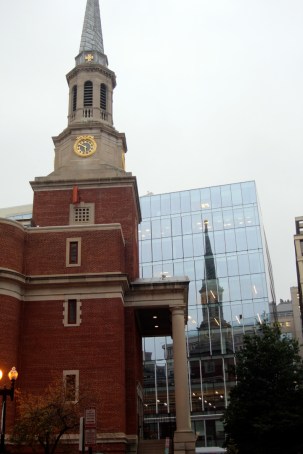
Out to find some Matchbox cars, I walked past this church in the area near our hotel.
I realized on my way to D.C. that I had forgotten to pack some materials I needed for the activity the next day. I had tape and spaghetti and paper, but forgot gumdrops and Matchbox cars. I went out on a supply run, looking for a CVS pharmacy or other convenience store near the Hyatt. I found gummi worms at one place about two blocks from the hotel, and finally found some Matchbox cars at a convenience store near the main gate to China Town. It was just down the street from the hotel and next door to the Mongolian Barbeque place I had eaten at for the Einstein Fellowship interviews a year and a half ago. Now supplied for my presentation, I returned to the hotel and spent the rest of the evening in my room writing blog posts for my Indonesia trip.
The next day we had breakfast in the conference room and a video keynote address from the CEO and founder of Regeneron, who started out as a Science Talent Search winner himself. This company is creating new drugs and medical breakthroughs using the human genome data, and one of the themes of this conference is how to use Big Data. The main keynote speaker was Lisa Purcell, Senior Staff Scientist with Regneron, who discussed Innovating with Rigor. She talked about what rigorous science entails and how to foster it in our classes. Students need to gain inspiration from multiple sources, understand that the data they collect are the data but are open to interpretation, so the interpretation itself needs to be rigorous, and that they need to ask good questions. As teachers, our job is to find motivated students, stimulate innovative thinking, and promote science as a way of thinking. Teachers are the first line advocates for science. Impactful science is innovative, and good science must be rigorous.

Cindy Rogers presenting her portion of our presentation on Preparing Students for Engineering Projects. We had a good group of about 30 teachers in our session.
In Session 1, I attended Kate Travis’ session on Visualizing Science. She is an editor of Science News, and the session was fascinating. She started with one of the first infographics ever created, a map of a cholera epidemic in London that showed all the cases originated from the Broadstreet water pump. She showed a recent and much more sophisticated map of a MERS outbreak in South Korea that had 308 million data points with demographic data that showed super spreaders and airports as hubs of pandemics. She showed video timelapses of glacier retreats based on normalized tourist photos, skycrapers sprouting over cities, visualizations of human migrations, and even one scientist’s daily tracking of his gut bacteria for a year. One of the most fascinating was a collection of GPS location data from research buoys released into the ocean and tracked, which created animations clearly showing ocean gyres such as the Great Pacific Garbage Patch. Another showed duration and speed of Category 5 hurricanes which is zoomable to individual storms, the area under the curve representing joules of energy produced or storm severity. One chart showed data on habitable exoplanets known to date.

Teachers in our session beginning to design and build their bridges. The purposes (specifications) were be 13 inches long and support the weight of a Matchbox car pushed across without the car falling into the Tacoma Narrows.
All these charts were zoomable and interactive, and she shared some online software for building such datasets, including StoryMapper, Tableau, and Google Charts. Now I need to check these out and learn how to use them, a big project in itself.
The workshop I chose for Session 2 was Research with Limited Resources by Mark Vondracek and Catherine Nolan. They said that Science Talent Search has 500-600 applicants per year, which is a lot, but many of them come from the same schools. There are 30,000 public high schools. Where are the students from the other 29,500+ schools? Most schools simply don’t have much training or budget for big science projects, but there are many types of projects that don’t require expensive equipment or where data are available online.
Mark spoke of three realms of student STEM research at small schools without extensive equipment: experimental, computational, and online Big Data. They shared a website: http://basement-science.blogspot.com. He talked about projects his students do, such as studying how liquids flow when poured from a higher position. They spread out in a laminar flow pattern for a few centimeters, but it quickly turns turbulent for reasons that are not well understood. They study fracture patterns in dropped apples, use online astrophysics data, NOAA climate data, and data from Fermilab, CERN, and other research labs.
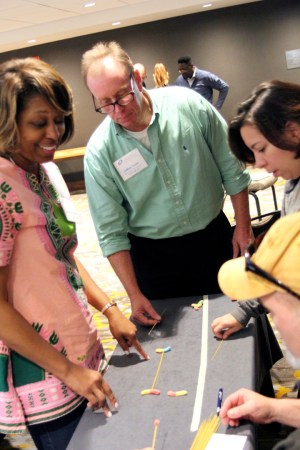
Teachers in our session laying out the design of their bridges.
Catherine spoke of how she instills experimental rigor into her students’ projects. She focuses on extensive background research, because one must be educated to make an educated guess. They use online journal sources, keep research journals, and are trained to ask critical questions of the articles they read. Since not all professional science journals are freely available, she partners with universities to allow her students to use their journal access. Her students use Python, GDL-GNU, DS9, and other free resources to unpack and analyze data sources. They use local data from the Forest Service, contact article authors directly, and work with local businesses to meet their research needs through student projects.
After lunch we had another plenary keynote speaker, Dr. Ruth Krumhasi of the Oceans of Data Institute. She started with EDC, which has been around since the Sputnik Era and had 1500 employees collecting scientific articles and data as a central clearinghouse. The ODI launched in 2015 as a way to teach data literacy tools. She spreads her time between two houses in Taos, NM and Nova Scotia and works remotely (nice if you can get it!) and works with the Large Synoptic Survey Telescope that is being built in Chile to set up a data analysis pipeline, among other things.

Teachers putting together the decks of their bridges for the engineering design challenge we gave them.
She talked about why we should teach how to use data. The reasons include a workforce imperative: many jobs now require data analysis skills such as accounting to track doctor effectiveness and forensic science to solve crimes; an educational imperative: big data requires a global perspective and awareness that aren’t being effectively taught (sounds familiar); and a social imperative: basic literacy now requires numeracy, or the ability to understand charts and graphs and interpret data. Those that can’t understand statistics will be controlled by those that can and who know how to manipulate data.
She spoke about how to teach data literacy through an acronym: CLIP: Complex – using multiple sources for data and multiple data sets; Large – abundant data, more than is needed to provide richness and show patterns; Interactive – to explore data, visualize it, break it down, and develop multiple interpretations; and Professional – collected with accuracy and reliability. She gave some examples and talked about the CODAP – common online data analysis platform.
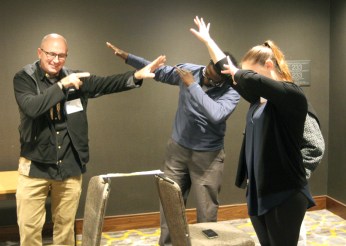
A teacher group after successfully navigating a Matchbox car over the Tacoma Narrows gorge. Tubby the Dog didn’t die this time!
Session 3 was my and Cindy’s presentation on the Engineering Design Process and the importance of collecting test data to analyze and inform revisions of projects. We each took about ten minutes. I described the engineering cycle and Cindy talked of projects she’s done to incorporate that cycle. We spent the bulk of the time on the challenge: to build a bridge that is 13 inches long made out of spaghetti noodles, gumdrops (or worms in this case), a short piece of masking tape, and one sheet of paper that can support a Matchbox car that is pushed across it. I showed the video of Galloping Gertie to set up the problem, then let them go for it. The solutions were diverse and the teachers enjoyed the hands-on activity. There were about 30 people in attendance, and it was well received. We could have used more time at the end to wrap up and tie in data usage more, but overall it was very successful.
For Session 4 I went to a workshop on Teachers as Researchers led by three teachers. They shared many opportunities out there to do original research, such as the RETs that I already knew about but some that I hadn’t. Two of them did biological research, but one did astrophysics research at the Solar Observatory at Kitt Peak in New Mexico.
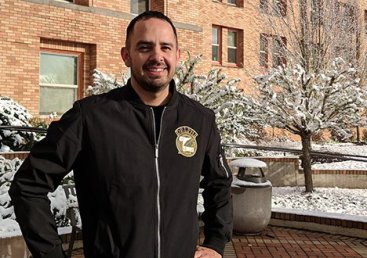
Diego Martinez, from the Delphian School in Oregon, who was one of the presenters I attended at the Research Teacher Data Conference. I first met Diego as a MAVEN Education Ambassador at Goddard Space Flight Center in 2015.
Session 5 was called Out of Your League: Harvesting Student Persistence. One of the teachers looked familiar, and I finally placed him – Diego Martinez from the MAVEN Education Ambassadors program two years ago. He was in Alamosa, Colorado (which I traveled through last summer) but is now at the Delphian School in Sheridan, Oregon near Lincoln City. It is one of the oldest charter schools in the country, and talking with him afterwards, it sounded like a great place to teach. He invited me to come visit the school sometime. Since then, I’ve seen that he was chosen as for the 2018 Alan Shepard Technology in Education Award by the Space Foundation and Astronauts Memorial Fund (see https://www.spacefoundation.org/news/science-teacher-diego-martinez-2018-recipient-alan-shepard-technology-education-award). The bio that was posted with the award states that he has done some incredible things in two years he has been at the Delphian School.
Their presentation was on how to get students to persist when they are unfamiliar with their subject matter, including getting them to understand the vocabulary of the subject by circling and looking up any unknown words in their background research. As they become conversant in the language of the subject, they will be better able to understand the subject. They demonstrated the problem of dealing with unfamiliar material by having groups analyze random pages from the Zoom book for 30 seconds and then try to organize them all – they showed a boat on a bus on a street on a stamp where contextual clues were absent to get a sense of scale, and how hard this was to do without references. This is how students look at an unfamiliar subject – they have no context from which to understand it.
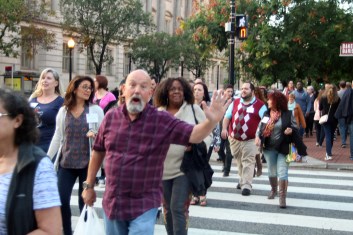
Teachers at the Research Data Conference on their way to dinner in Washington, D.C.
We met together in the main banquet hall and Caitlin finished up the day by talking about how to use I Wonder journals to get students to ask questions, then gradually build in more rigor and depth with time such as starting with basic questions, then deeper questions with research, asking experts, etc. until they develop a great research question. She wondered if one could open up a sample of air bottled inside a 7-11 or a Panera Bread and still be able to recognize the smell. The question became how one would collect the air – walk through the store with a sweater on?
We divided into groups and walked together to an Italian restaurant nearby. We had about 50 people in the group, but they were ready for us and had seats all arranged. I tried to sit by people I hadn’t yet spoken to, and talked with a lady next to me that had done an internship developing lesson materials. When I told her I had actually used those materials in my own classes, she was pleased to find out her work was still out there.

Alignment of the Capitol and the Washington Monument on our tour of D.C. on Oct. 14, 2017.
After dinner we walked back to the Grand Hyatt and had some time to change, then those that were interested met in the lobby where two buses took us to see some of the monuments around the Mall. We stopped at the World War II and the Martin Luther King, Jr. Memorials. I was able to get better photos of them now that I have a nicer camera. Then we bused across the street to the Korean War Memorial and the Lincoln Memorial. A group of high school students were there for a party associated with their prom without much supervision, and they were a bit noisy but not really acting out too badly – it’s hard to get too active in formal wear. Some of the teachers with us complained. That tells me they must have very quiet students if this small amount of noise bothered them. Maybe they felt that the students were being too irreverent at such a hallowed spot, but if I lived in the D.C. area, I would probably take these sites for granted, too.

Martin Luther King, Jr. memorial in Washington, D.C. It was nice to have a better camera this time.
I was getting pretty tired by this point and I had been to all of these sites before, and was becoming weary of socializing. As good as this day had been, I still just wanted to get back to the hotel.
On Sunday, Oct. 15, 2017 I got ready and went down to an excellent breakfast served in the main banquet room of the Grand Hyatt. I had taken my time packing up and getting out of my room, then checking my luggage at the front desk, and was one of the last to arrive for breakfast. While I finished eating I listened as Maya Amjira, CEO of the Society for Science and the Public, addressed us. She was an STS alumnus herself, with a project on duckweed growth. Then Allie Stifel, Director of STS described the program to us. Having submitted my own science fair project as a candidate for the Science Talent Search back as a senior in high school, it was interesting to see the program from the other side. 13 Nobel Prize winners started out in STS, including Kip Thorne. It is a direct apply program – you don’t have to go through qualifying fairs like ISEF. She went through the requirements and deadlines, the prizes for winners (I did win Fourth Place in the Utah STS, but never got close to the national STS).

Statue of Abraham Lincoln in the Lincoln Memorial in Washington, D.C.
We then divided up for sessions and I went to one by Joanne Barrett from Out of Doors Academy in Florida on Using Technology in Research. She spoke of the role of teachers to help scaffold the data that students use and how to teach critical thinking. Technology makes finding and analyzing data easy, but that doesn’t mean the students know what to do with it or what it all means. She went over some online tools for data analysis and citation management that I wasn’t aware of before and some tools such as Wolfram Alpha and MathLab that I’ve heard of but need to learn. Gwen Jefferson of Rialto, CA talked about using handheld devices and types of projects her students have done and how she’s managed the data reporting and abstract requirements of projects.

World War II memorial and Washington Monument.
This was the last session that I have notes for; I remember going to one other but can’t remember the topic. It had been a busy two days and I was dragging by the end. There wasn’t really a final session for all of the teachers together to summarize the experience, so we were free to make our ways home. We had scheduled buses back to the airport, and mine was a bit later than others, so I got my luggage from the front desk and put it in the belly of the bus when it first arrived. I had some time to hang out before the bus left, so I went for a short walk around the area – down toward China Town, where I found a courtyard with colorful vines growing overhead and interestingly painted animal statues.
Returning to the hotel, I climbed aboard the bus and waited for 15 minutes before it left. As other teachers got on, I talked with them and encouraged them to apply for the Teachers for Global Classrooms program, which several said they would look into. I guess that I am an evangelist for the program now.

Fall vines and colorful camels, in a courtyard near the entrance to Chinatown in Washington, D.C.
I took a few more photos of the Capitol Building and other monuments on our way back to the Reagan Airport. I was there in plenty of time, as my usual flight wasn’t until 5:20, so I checked my bag and walked to the terminal and ate a good hamburger there. I had to be careful about the amount of money I spent, given that I have no income. I wanted to have some extra per diem left over on the $100 credit card we were given to cover meals.
I walked through Security without problem and waited at the gate, the same one I’ve used for the last several trips to D.C. I had about an hour to wait, and tried to read Most Likely to Succeed but kept dozing off. Finally my flight boarded and I had an uneventful trip back to Utah.

A decent photo of the Jefferson Memorial as we drove past on our way back to the airport.
There are so many things I would like to try out that I learned at this conference, but will have to wait until I have students again. When I do get re-hired, I hope it is in a place where we can learn some of these possibilities. In the meantime, I have good notes. As much as I think my students have been doing these things, I’ve found there is so much more to discover, a whole level of effort above anything I thought was possible. I feel like a rank amateur compared to some of the teachers I’ve met this weekend.
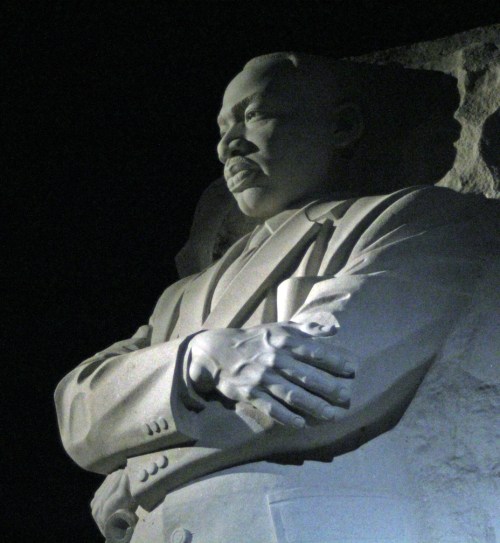
Dr. King gazing out across the Tidal Basin.


